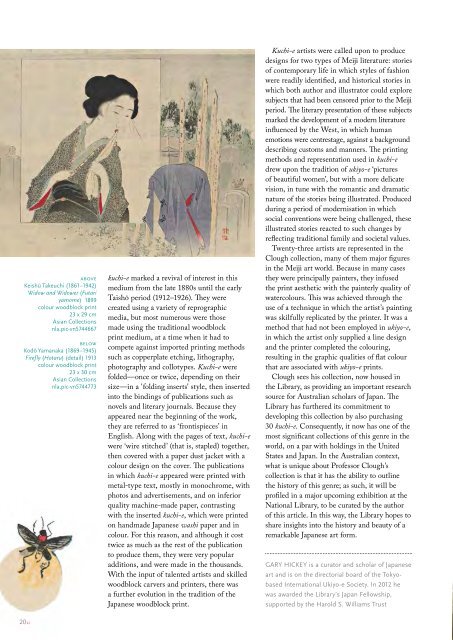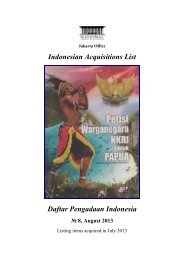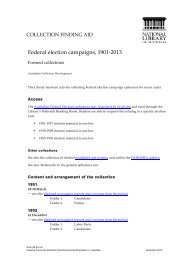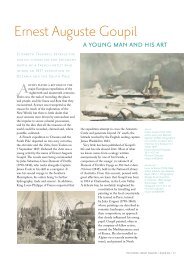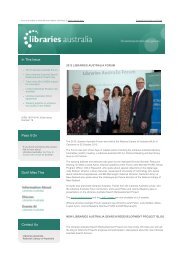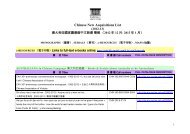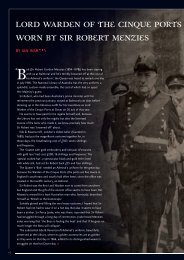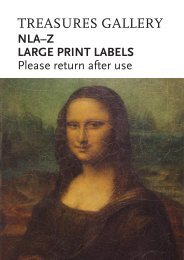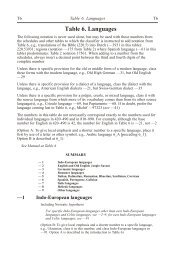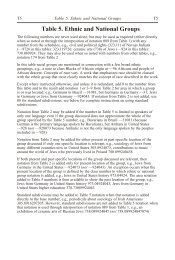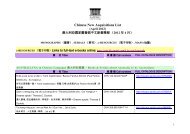Download the National Library Magazine - National Library of ...
Download the National Library Magazine - National Library of ...
Download the National Library Magazine - National Library of ...
Create successful ePaper yourself
Turn your PDF publications into a flip-book with our unique Google optimized e-Paper software.
above<br />
Keishū Takeuchi (1861–1942)<br />
Widow and Widower (Futari<br />
yamome) 1899<br />
colour woodblock print<br />
23 x 29 cm<br />
Asian Collections<br />
nla.pic-vn5744667<br />
below<br />
Kodō Yamanaka (1869–1945)<br />
Firefly (Hotaru) (detail) 1913<br />
colour woodblock print<br />
23 x 30 cm<br />
Asian Collections<br />
nla.pic-vn5744773<br />
kuchi-e marked a revival <strong>of</strong> interest in this<br />
medium from <strong>the</strong> late 1880s until <strong>the</strong> early<br />
Taishō period (1912–1926). They were<br />
created using a variety <strong>of</strong> reprographic<br />
media, but most numerous were those<br />
made using <strong>the</strong> traditional woodblock<br />
print medium, at a time when it had to<br />
compete against imported printing methods<br />
such as copperplate etching, lithography,<br />
photography and collotypes. Kuchi-e were<br />
folded—once or twice, depending on <strong>the</strong>ir<br />
size—in a 'folding inserts' style, <strong>the</strong>n inserted<br />
into <strong>the</strong> bindings <strong>of</strong> publications such as<br />
novels and literary journals. Because <strong>the</strong>y<br />
appeared near <strong>the</strong> beginning <strong>of</strong> <strong>the</strong> work,<br />
<strong>the</strong>y are referred to as ‘frontispieces’ in<br />
English. Along with <strong>the</strong> pages <strong>of</strong> text, kuchi-e<br />
were ‘wire stitched’ (that is, stapled) toge<strong>the</strong>r,<br />
<strong>the</strong>n covered with a paper dust jacket with a<br />
colour design on <strong>the</strong> cover. The publications<br />
in which kuchi-e appeared were printed with<br />
metal-type text, mostly in monochrome, with<br />
photos and advertisements, and on inferior<br />
quality machine-made paper, contrasting<br />
with <strong>the</strong> inserted kuchi-e, which were printed<br />
on handmade Japanese washi paper and in<br />
colour. For this reason, and although it cost<br />
twice as much as <strong>the</strong> rest <strong>of</strong> <strong>the</strong> publication<br />
to produce <strong>the</strong>m, <strong>the</strong>y were very popular<br />
additions, and were made in <strong>the</strong> thousands.<br />
With <strong>the</strong> input <strong>of</strong> talented artists and skilled<br />
woodblock carvers and printers, <strong>the</strong>re was<br />
a fur<strong>the</strong>r evolution in <strong>the</strong> tradition <strong>of</strong> <strong>the</strong><br />
Japanese woodblock print.<br />
Kuchi-e artists were called upon to produce<br />
designs for two types <strong>of</strong> Meiji literature: stories<br />
<strong>of</strong> contemporary life in which styles <strong>of</strong> fashion<br />
were readily identified, and historical stories in<br />
which both author and illustrator could explore<br />
subjects that had been censored prior to <strong>the</strong> Meiji<br />
period. The literary presentation <strong>of</strong> <strong>the</strong>se subjects<br />
marked <strong>the</strong> development <strong>of</strong> a modern literature<br />
influenced by <strong>the</strong> West, in which human<br />
emotions were centrestage, against a background<br />
describing customs and manners. The printing<br />
methods and representation used in kuchi-e<br />
drew upon <strong>the</strong> tradition <strong>of</strong> ukiyo-e ‘pictures<br />
<strong>of</strong> beautiful women’, but with a more delicate<br />
vision, in tune with <strong>the</strong> romantic and dramatic<br />
nature <strong>of</strong> <strong>the</strong> stories being illustrated. Produced<br />
during a period <strong>of</strong> modernisation in which<br />
social conventions were being challenged, <strong>the</strong>se<br />
illustrated stories reacted to such changes by<br />
reflecting traditional family and societal values.<br />
Twenty-three artists are represented in <strong>the</strong><br />
Clough collection, many <strong>of</strong> <strong>the</strong>m major figures<br />
in <strong>the</strong> Meiji art world. Because in many cases<br />
<strong>the</strong>y were principally painters, <strong>the</strong>y infused<br />
<strong>the</strong> print aes<strong>the</strong>tic with <strong>the</strong> painterly quality <strong>of</strong><br />
watercolours. This was achieved through <strong>the</strong><br />
use <strong>of</strong> a technique in which <strong>the</strong> artist’s painting<br />
was skilfully replicated by <strong>the</strong> printer. It was a<br />
method that had not been employed in ukiyo-e,<br />
in which <strong>the</strong> artist only supplied a line design<br />
and <strong>the</strong> printer completed <strong>the</strong> colouring,<br />
resulting in <strong>the</strong> graphic qualities <strong>of</strong> flat colour<br />
that are associated with ukiyo-e prints.<br />
Clough sees his collection, now housed in<br />
<strong>the</strong> <strong>Library</strong>, as providing an important research<br />
source for Australian scholars <strong>of</strong> Japan. The<br />
<strong>Library</strong> has fur<strong>the</strong>red its commitment to<br />
developing this collection by also purchasing<br />
30 kuchi-e. Consequently, it now has one <strong>of</strong> <strong>the</strong><br />
most significant collections <strong>of</strong> this genre in <strong>the</strong><br />
world, on a par with holdings in <strong>the</strong> United<br />
States and Japan. In <strong>the</strong> Australian context,<br />
what is unique about Pr<strong>of</strong>essor Clough’s<br />
collection is that it has <strong>the</strong> ability to outline<br />
<strong>the</strong> history <strong>of</strong> this genre; as such, it will be<br />
pr<strong>of</strong>iled in a major upcoming exhibition at <strong>the</strong><br />
<strong>National</strong> <strong>Library</strong>, to be curated by <strong>the</strong> author<br />
<strong>of</strong> this article. In this way, <strong>the</strong> <strong>Library</strong> hopes to<br />
share insights into <strong>the</strong> history and beauty <strong>of</strong> a<br />
remarkable Japanese art form.<br />
GARY HICKEY is a curator and scholar <strong>of</strong> Japanese<br />
art and is on <strong>the</strong> directorial board <strong>of</strong> <strong>the</strong> Tokyobased<br />
International Ukiyo-e Society. In 2012 he<br />
was awarded <strong>the</strong> <strong>Library</strong>’s Japan Fellowship,<br />
supported by <strong>the</strong> Harold S. Williams Trust<br />
20::


